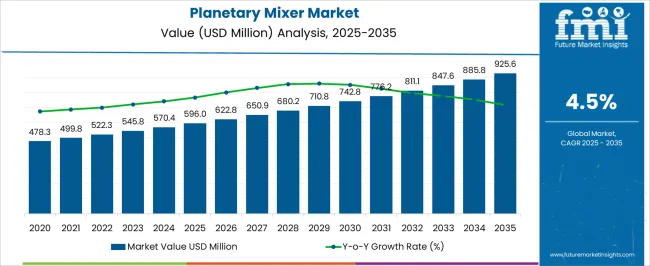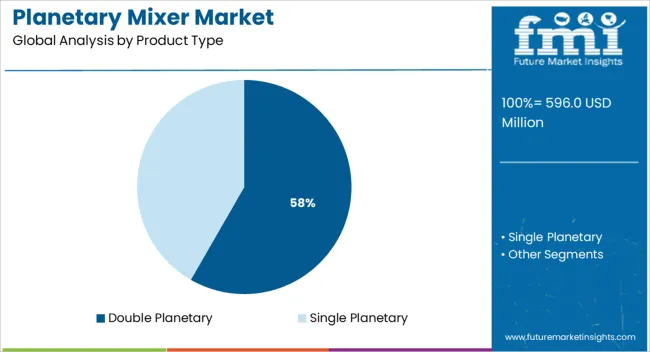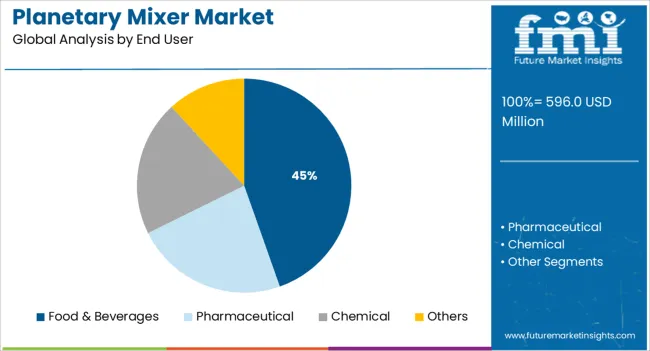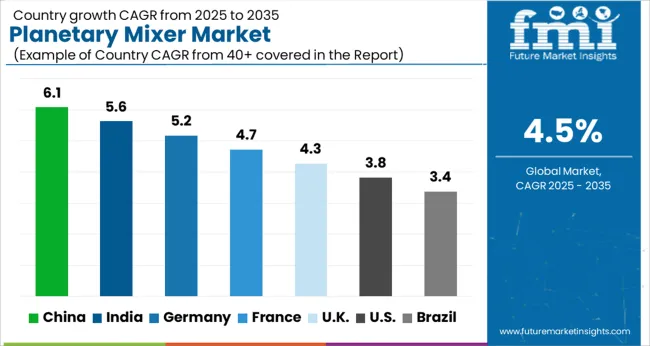The Planetary Mixer Market is estimated to be valued at USD 596.0 million in 2025 and is projected to reach USD 925.6 million by 2035, registering a compound annual growth rate (CAGR) of 4.5% over the forecast period.

| Metric | Value |
|---|---|
| Planetary Mixer Market Estimated Value in (2025 E) | USD 596.0 million |
| Planetary Mixer Market Forecast Value in (2035 F) | USD 925.6 million |
| Forecast CAGR (2025 to 2035) | 4.5% |
The Planetary Mixer Market is experiencing consistent expansion, supported by the rising demand for efficient and high-performance mixing equipment across industries. Current trends indicate a strong push from manufacturers in food, pharmaceuticals, and chemicals to adopt advanced mixing technologies that enable higher productivity, consistency, and sanitation. Industry announcements and equipment launches have highlighted a shift toward customized and energy-efficient planetary mixers, tailored to specific viscosity and batch requirements.
Regulatory focus on hygiene and process compliance, especially in food and life sciences, has further driven adoption. Technological innovation in motor systems, programmable control interfaces, and interchangeable attachments has broadened the application range of these machines.
Increased investments in automation and the global growth of bakery, processed foods, and specialty chemical production have reinforced future growth potential As production demands become more complex and precise, planetary mixers are expected to remain a cornerstone in industrial and commercial mixing environments, particularly in regions undergoing industrial modernization and expansion.
The market is segmented by Product Type and End User and region. By Product Type, the market is divided into Double Planetary and Single Planetary. In terms of End User, the market is classified into Food & Beverages, Pharmaceutical, Chemical, and Others. Regionally, the market is classified into North America, Latin America, Western Europe, Eastern Europe, Balkan & Baltic Countries, Russia & Belarus, Central Asia, East Asia, South Asia & Pacific, and the Middle East & Africa.

The double planetary product type is projected to account for 58.3% of the Planetary Mixer Market revenue share in 2025, establishing it as the leading product segment. This dominance is attributed to its superior ability to mix high-viscosity materials with uniform consistency and reduced batch time. Industry publications and product engineering bulletins have indicated that this mixer type is being favored in applications requiring gentle yet thorough blending, such as doughs, slurries, and viscous pastes.
Manufacturers have adopted double planetary mixers due to their dual blade design, which allows both rotation and revolution, ensuring complete material turnover without dead zones. The segment's growth has been supported by demand from industries where high-quality mixing is critical to product performance and safety.
Its operational versatility, enhanced discharge systems, and ability to handle both small and large batches have made it a preferred choice in both automated and semi-automated production setups These technical and operational advantages have solidified the segment’s dominant position in the global market.

The food and beverages end user segment is expected to hold 44.6% of the Planetary Mixer Market revenue share in 2025, maintaining its position as the most significant contributor by end-use. Growth in this segment is being propelled by the rapid expansion of the processed food and bakery sectors, along with rising consumer demand for consistent product quality. Corporate reports and commercial equipment trends have shown that food processors are increasingly adopting planetary mixers to achieve uniform blending of dough, batters, sauces, and fillings.
Regulatory emphasis on food safety and hygiene has encouraged the use of stainless-steel mixing systems with easy-clean designs, a key feature of planetary mixers. Furthermore, the segment has benefited from rising investments in commercial kitchen infrastructure and automation in food production facilities.
Demand for versatile mixing equipment capable of scaling from artisanal to mass production has reinforced the appeal of planetary mixers in this segment These factors have contributed to the segment's continued leadership in 2025.
The global planetary mixer market was valued at USD 596 Million in 2025 and is expected to reach USD 925.6 million by 2035, growing at a CAGR of 4.5% during the forecast period from 2025 to 2035. The historical outlook for the global planetary mixer market has been positive, with the market growing at a CAGR of 4.2% from 2020 to 2025. This growth can be attributed to the increasing demand for food mixers from the food and beverage industry and the rising popularity of planetary mixers in home kitchens.
In June 2025, for instance, RSPL Group introduced Baker By Chance, a new brand to offer bakery products to fulfill the high demand from evolving consumers. It would provide baked goods made of quality and fresh ingredients. Such new brand launches by renowned conglomerates are estimated to augur well for planetary mixer sales.
Various factors are responsible for propelling growth in the planetary mixer market. Lead analysts at Future Market Insights have conducted extensive research work to find out upcoming trends, threats, growth opportunities, driving factors, obstacles, and recent developments that can affect the market in the given time frame.
The drivers, restraints, opportunities, and threats (DROTs) identified are as follows:
DRIVERS
RESTRAINTS
OPPORTUNITIES
THREATS


Bakery Machinery Manufacturers across the USA Focus on Providing FDA-Compliant Products
In the US, planetary mixers are extensively used in a variety of settings, from bakeries and restaurants to laboratories and manufacturing facilities. In most cases, these mixers are affected by the same issues that any other type of mixer would be affected by such as power outages or equipment failures. However, there are some specific issues that can impact sales of planetary mixers in the USA such as the Food and Drug Administration’s (FDA) regulation associated with food contact surfaces.
As per this regulation, all surfaces that come into contact with food must be made of materials that are safe for human consumption. This includes mixing bowls, paddles, and other attachments. As a result, many mixer manufacturers have had to change the materials they use to make their products compliant with this regulation.
Industry Development Projects across India to Propel Sales of Heavy Duty Planetary Mixers
India is set to be a land of opportunity for those looking to start or expand their businesses in the planetary mixer industry. With a population of over 1.3 billion people, there is a large potential customer base for businesses to tap into.
The Indian government is also supportive of businesses in this sector, offering various incentives and tax breaks to encourage investment. Additionally, with many development projects underway in the country, there is a growing demand for bakery equipment, which presents an opportunity for businesses supplying planetary mixers.
In order to take advantage of new opportunities available in India, businesses need to have a good understanding of the local market. They should be able to adapt their products and services to meet the needs of Indian customers. Those that are able to do this successfully can reap the rewards of doing business in one of the most populous and rapidly growing countries in the world.
Low Cost of Labor to Help Chinese Bakery Equipment Manufacturers Open their Facilities
According to FMI, the planetary mixer market in China is rising at a peak stage. The evolution pace is set to be the most rapid in 2025 when imports are projected to surge by a CAGR of 5.8%. The country has a large population and thus will have easy access to a vast potential customer base. Additionally, China's economy is growing rapidly. The country's GDP exceeded nearly USD10 trillion by 2024. This will further provide a significant boost to businesses operating in China.
Another reason why China is an attractive market for planetary mixer companies is its low labor costs. Wages in China are much lower than in other developed countries, making it an attractive destination for manufacturing and other labor-intensive industries.
Additionally, the Chinese government is increasingly investing in infrastructure projects, which would create new opportunities for businesses involved in baking. Finally, China's culture and history would offer a unique opportunity for businesses looking to tap into the vast potential market.
Launch of New Baked Snacks to Propel Demand for Planetary Cooking Mixers
Based on end users, the food and beverage segment is anticipated to dominate the global planetary mixer market in the next ten years. Increasing usage of these mixers in the bakery industry for making cookies, cakes, bread, and pastries is projected to drive sales. Besides, numerous bakeries in various parts of the globe are striving to attract a large consumer base by coming up with unique products, which would aid growth.
In October 2024, for instance, Crazy Snacks Private Limited, which is a renowned manufacturer of bakery products based in India, launched cupcakes and layer cakes to enter the cake segment. The company aims to offer affordable and delicious snack options to price-conscious consumers across the country. Thus, such product launches are likely to enable key players to boost sales of planetary mixers.

Some of the most popular brands in the global planetary mixer industry include Hobart, KitchenAid, and Cuisinart. The majority of the key companies are focusing on growth strategies such as product approvals, product launches, participating in events, and bagging patents. A few other key players are engaging in inorganic growth strategies like partnerships and collaborations, as well as mergers and acquisitions.
For instance,
| Attribute | Details |
|---|---|
| Estimated Market Size (2025) | USD 596.0 million |
| Projected Market Valuation (2035) | USD 925.6 million |
| Value-based CAGR (2025 to 2035) | 4.5% |
| Forecast Period | 2025 to 2035 |
| Historical Data Available for | 2020 to 2025 |
| Market Analysis | Value (USD Million) |
| Key Regions Covered | North America; Latin America; Europe; Asia Pacific; Oceania; Middle East & Africa (MEA) |
| Key Countries Covered | The USA, Canada, Mexico, Germany, The UK, France, Italy, Spain, China, Japan, India, South Korea, Australia, Brazil, Argentina, South Africa, UAE |
| Key Segments Covered | Product Type, End User, Region |
| Key Companies Profiled | Sower Group; Univex Corporation; Sammic S.L.; VMI, Li Yuan Machine Industrial Co. Ltd.; Dito Sama |
| Report Coverage | Market Forecast, Company Share Analysis, Competitive Landscape, DROT Analysis, Market Dynamics and Challenges, and Strategic Growth Initiatives |
The global planetary mixer market is estimated to be valued at USD 596.0 million in 2025.
The market size for the planetary mixer market is projected to reach USD 925.6 million by 2035.
The planetary mixer market is expected to grow at a 4.5% CAGR between 2025 and 2035.
The key product types in planetary mixer market are double planetary and single planetary.
In terms of end user, food & beverages segment to command 44.6% share in the planetary mixer market in 2025.






Full Research Suite comprises of:
Market outlook & trends analysis
Interviews & case studies
Strategic recommendations
Vendor profiles & capabilities analysis
5-year forecasts
8 regions and 60+ country-level data splits
Market segment data splits
12 months of continuous data updates
DELIVERED AS:
PDF EXCEL ONLINE
Industrial Planetary Gearbox Market Analysis & Forecast 2025 to 2035
Mixers & Attachments Market
Mixers Market
Feed Mixer for Livestock Market Size and Share Forecast Outlook 2025 to 2035
Feed Mixer Market Forecast and Outlook 2025 to 2035
Meat Mixers Market Size and Share Forecast Outlook 2025 to 2035
Mill Mixer Market Size and Share Forecast Outlook 2025 to 2035
Batch Mixer Market Growth - Trends & Forecast 2024-2034
Vortex Mixer Market Size and Share Forecast Outlook 2025 to 2035
Batter Mixer Machines Market Analysis by Product Capacity, Application, and Region 2025 to 2035
Commercial Mixers Market Size and Share Forecast Outlook 2025 to 2035
High Shear Mixer Market Size and Share Forecast Outlook 2025 to 2035
Industrial Mixer Market Size and Share Forecast Outlook 2025 to 2035
Bone Cement Mixers Market
High Viscosity Mixer Market Size and Share Forecast Outlook 2025 to 2035
Global Nutating Mixers Market
Commercial Drink Mixers Market Size and Share Forecast Outlook 2025 to 2035
Competitive Breakdown of Food Blender and Mixer Providers
Food Blender and Mixer Market Trends – Growth & Outlook 2024-2034
Self-loading Feed Mixer Market Growth – Trends & Forecast 2024-2034

Thank you!
You will receive an email from our Business Development Manager. Please be sure to check your SPAM/JUNK folder too.
Chat With
MaRIA